
REGULAR ARTICLE
Application of the EGPT methodology in the analysis of small-
sample reactivity worth experiments
Pierre Leconte
1,*
, Jean Tommasi
1
, Alain Santamarina
2
, Patrick Blaise
3
, and Paul Ros
3
1
CEA, DEN, DER/SPRC/LEPh Cadarache, 13108 Saint Paul-Lez-Durance, France
2
CEA, DEN, DER/SPRC Cadarache, 13108 Saint Paul-Lez-Durance, France
3
CEA, DEN, DER/SPEx/LPE Cadarache, 13108 Saint Paul-Lez-Durance, France
Received: 3 December 2017 / Received in final form: 12 February 2018 / Accepted: 7 June 2018
Abstract. In the current paper, we investigate the application of the Equivalent Generalized Perturbation
Theory (EGPT) to derive trends and associated covariances on the neutron capture cross section of one major
fission product for both light water reactors and sodium-cooled fast reactors which is Rhodium-103. To do so, we
have considered the ERMINE-V/ZONA1 & ZONA3 fast spectrum experiment and the MAESTRO thermal-
spectrum experiment, where samples of these materials were oscillated in the MINERVE facility. In the paper,
the theoretical formulation of EPGT is described and its derivation in the special case of the close loop oscillation
technique where the reactivity worth is determined thanks to a power control system. A numerical benchmark is
presented to assess the relevance of sensitivity coefficients provided by EGPT against direct perturbations where
the microscopic cross sections are manually changed before calculating the adjoint and forward flux. The
breakdown between direct and indirect contributions in the sensitivity analysis of the sample reactivity worth is
presented and discussed, with the impact of using a calibration reference sample to normalize the measured
reactivity worth. Finally, the assimilation of integral trends is done with the CONRAD code, using C/E
comparisons between TRIPOLI4/JEFF3.2 calculations and experimental results and the sensitivity coefficients
provided by the EGPT. Preliminary results of this study are showing that the JEFF3.2 evaluation of
103
Rh gives
satisfactory agreements in both thermal and fast spectrum experiments and that the combination of them can
lead to a significant uncertainty reduction on the capture cross section, from ±5% to ±3% in the resolved
resonance range (1 eV–10 keV) and from ±8% to ±5% in the unresolved resonance range (10 keV–1 MeV).
1 Introduction
Small-sample reactivity worth (SSRW) experiments [1]
are referring to the measurement of the reactivity
change of an experimental reactor, induced by the
oscillation of a geometrically small sample containing a
material to be tested. Several specificities are defining
these experiments:
–Thesampleissaidtobesmallrelativelytothecore
size. Typical geometries are rods of 1 cm in diameter
and 10 cm in length. Such dimensions are adapted
so that for a sample which is loaded in the radially
and axially center of the core, any position inside
thesamplevolumeseesalmostthesameneutronflux.
The interest is also to minimize the leakage contribu-
tion, as the forward and adjoint flux gradients are
negligible.
–The sample usually involves a reactivity change of a few
pcm or a few tens of pcm (1 pcm = 10
5
), with typical
experimental uncertainties of about 10
2
pcm. The conse-
quence of such low reactivity effect is that the global
production rate is weakly modified by the sample.
–The sample is usually fabricated from a very pure material,
so it contains a limited number of elements or isotopes.
–Under special spectral conditions [2], resulting from an
adequate core configuration, it is possible to emphasis
one type of reaction against all the possible ones (for
instance: capture or scattering).
As a consequence, SSRW experiments have much
less degrees of freedom than k
eff
experiments, such like the
ones considered in the ICSBEP database, and appear to
be very relevant for nuclear data improvement of single
isotopes and/or reactions.
The calculation of SSRW experiments is a tricky issue
which was already discussed in details in various previous
papers. It now benefits of strong improvements provided
*e-mail: pierre.leconte@cea.fr
EPJ Nuclear Sci. Technol. 4, 44 (2018)
©P. Leconte et al., published by EDP Sciences, 2018
https://doi.org/10.1051/epjn/2018041
Nuclear
Sciences
& Technologies
Available online at:
https://www.epj-n.org
This is an Open Access article distributed under the terms of the Creative Commons Attribution License (http://creativecommons.org/licenses/by/4.0),
which permits unrestricted use, distribution, and reproduction in any medium, provided the original work is properly cited.

by the new capacility of the TRIPOLI4 Monte-Carlo
code [3] to compute reactivity worth using an exact
perturbation formalism [4], based on the Iterated Fission
Probability (IFP) method. In previous methods that relied
on deterministic codes, discretizations in energy, space
and angle had to be carefully validated against stochastic
calculations, using benchmark patterns. This new method
represents a major scientifc breakthrough that now also a
reference three-dimensional calculations, using continuous
energy/angle cross sections.
However, while the IFP method succeeds in computing
very small reactivity worth, without limitations on the
reactivity amplitude, there is still an open question of how
to evaluate the feedback on the input nuclear data, based
on the comparison of the calculated and measured data.
There are usually two ways to proceed:
–Compute direct perturbations of the input nuclear data,
in the ENDF-6 file or in the application library which
is loaded by the code. Such methods require as many
calculations as input parameters.
–Compute sensitivity coefficients, using the Generalized
or Equivalent Generalized Perturbation Theory (respec-
tively GPT or EGPT). Such methods have the advantage
to provide the contribution of all reactions from all the
isotopes in a single calculation.
In the current work, we investigate the applicability
of the EGPT method, based on deterministic calculations
using the APOLLO-2.8 [5] and ERANOS-2.1 [6] codes.
In the first part, we will remind some basics on the EGPT
method, and will suggest an alternative formulation, to
better represents what is actually measured in the
experiment. A numerical benchmark will be presented
to assess the reliability of the method against direct
perturbation calculations. In the second part, we will
present an application of the proposed methodology to
analyse two different experiments related to the capture
cross section of Rhodium-103.
2 The EGPT method applied to SSRW
experiments
2.1 The standard EGPT method
Reactivity worth can be defined by the balance equations of
two different states:
–Initial state (noted 1):
F1
k1
A1
F1¼0ð1Þ
–Final state (noted 2):
F2
k2
A2
F2¼0ð2Þ
where Fand Arespectively stand for the fission source term
operator and the transport+removal+scattering operator,
Ffor the neutron flux and kfor the normalization factor
of F.
The reactivity worth is defined as:
Dr¼1=k11=k2:ð3Þ
Now, letus define the sensitivity Slike the relative
variation of a macroscopic quantity Qwith respect to a
relative variation of the input parameter p:
S¼
dQ
Q
dp
p
:ð4Þ
The EGPT method [7] proposes to evaluate the
sensitivity of the reactivity worth Dr=r
2
r
1
to a given
parameter pas the difference of sensitivities of the two
multiplication factors k
1
and k
2
. The latter is obtained
from the standard perturbation theory, by computing
the adjoint flux F
+
and convoluting it into the balance
equations (1) and (2). Then, the following equation is
obtained as:
SðDp;pÞ¼
dDQ
DQ
dp
p
¼1
Dr
Sðk2;pÞ
k2
Sðk1;pÞ
k1
¼1
Dr
〈Fþ
1;A1F1
k1
pF1〉
〈Fþ
1;F1
k1F1〉
〈Fþ
2;A2F2
k2
pF2〉
〈Fþ
2;F2
k2F2〉
2
6
43
7
5:
ð5Þ
The brackets with index pare referring to the
restriction of Aand Fto the terms that depend on p.
Using such formulation, we end-up with sensitivities
of Drto the total neutron multiplicity vequal to 1. This
linear dependence of Drwith vis not intuitive, as the
initial state with the sample withdrawn from the core
is usually exactly critical.
2.2 The alternative EGPT method
An alternative way to ensure that the reactivity worth
will not depend anymore on the total neutron multiplici-
ty is to keep the same normalization k
1
of the fission
source for both states. Then the two balance equations
become:
–Initial state (noted 1):
F1=k1
1A1
F1¼0ð6Þ
–Final state (noted 2):
F2=k1
k2=k1
A2
F2¼0:ð7Þ
The reactivity worth is now defined by:
Dr0¼1k1
k2
:ð8Þ
2 P. Leconte et al.: EPJ Nuclear Sci. Technol. 4, 44 (2018)

And the sensitivity of Dr
0
becomes:
SðDp0;pÞ¼
dDr0
Dr0
dp
p
¼1Dp0
Dr0½Sðk2;pÞSðk1;pÞ
¼1
Dr0"k1
〈Fþ
1;A1F1
k1
pF1〉
〈Fþ
1;F1
k1F1〉
k2
〈Fþ
2;A2F2
k2
pF2〉
〈Fþ
2;F2
k2F2〉#:ð9Þ
This alternative formulation ends up with a sensitivity
to the total multiplicity vequal to zero, which appears
to be more physical.
2.3 Numerical validation of the EGPT method
A numerical benchmark was defined to test the computa-
tion of senstivities through the alternative EGPT method
against a direct perturbation method. It is based on
the APOLLO2 deterministic code, using the reference
SHEM-MOC calculation scheme, and a simple geometry
consisting of a 2D 7 7 lattice of UO
2
fuel pins, moderated
with light water (Fig. 1). The central cell is made of the
fuel than the rest of the lattice (initial state 1) or poisoned
with a small amount of
103
Rh (final state 2). Thanks to
the use of the optimized 281 energy group SHEM mesh,
the 1.26 eV resonance of
103
Rh is well described and allows
an accurate calculation of the forward and adjoint flux
depression without the application of a self-sielding
formalism. The size of this benchmark was adapted to
maximize the sample reactivity worth but keeping a
spectrum in the central cell still representative of the one
imposed by the surrounding cells.
In the direct perturbation method, the sensitivity is
evaluated as follows:
SðDp;pÞ¼
1k01
k02
1k1
k2
1ð10Þ
k
0
is the multiplication factor computed with the input
paramater pperturbed to p+dp.
In the alternative EGPT method, the sensitivity is
evaluated like in equation (9).
In Table 1, we present the results of the 1-group
sensitivity coefficients for the main isotopes appearing in
the model and for the main contributing reactions. The
results for the direct perturbation method were obtained
with a 1% variation of the corresponding partial cross
sections. Note that the sensitivity to fission includes both
the absorption and neutron production terms.
Firstly, we confirm that the total neutron multiplicity v
has a sensitivity of zero in the alternative EGPT method, as
well as the direct perturbation one, while the standard one
is close to unity. Secondly, the different tested reactions are
showing acceptable agreements between the two methods,
considering that the few percents differences could be
attributed to the eigenvalue convergence, which is set to
10
1
pcm in the current calculation.
It is also instructive to compare the sensitivity
coefficients between the two methods, as it can be seen
in Table 1. Equivalent results are obtained for the direct
effects that are linked to the addition of
103
Rh inside the
central fuel. However, for indirect terms, the alternative
formulation appears to be more “physical”as all the
absorption terms have the same negative sign, which is
consistent with the fact that the sample reactivity worth
Table 1. Comparison of 1-group sensitivity coefficients between the two EGPT methods and the reference direct
perturbation method.
Method Isotope s
c
s
f
s
el
v
tot
Direct perturbation (reference)
103
Rh 0.940 –––
235
U–0.267 –0.062
238
U0.105 ––0.065
1
H––0.348 –
Standard EGPT
103
Rh 0.917 <0.001 0.001 –
235
U 0.067 0.532 0.001 0.818
238
U0.063 0.104 0.067 0.127
1
H 0.014 –0.738 –
Alternative EGPT
103
Rh 0.917 –0.001 –
235
U0.056 0.251 0.001 0.062
238
U0.064 0.064 0.013 0.065
1
H0.04 –0.382 –
Fig. 1. Geometrical model of the numerical benchmark.
P. Leconte et al.: EPJ Nuclear Sci. Technol. 4, 44 (2018) 3

should decrease when the absorption over the isotopes
from core increases, while in the standard formulation,
capture and fission terms act with opposite signs. These
differences in signs are the direct consequences of the
addition of k
1
and k
2
factors in equations (5) and (9).
3 Application to SSRW experiments related
to
103
Rh capture
To illustrate the application of the alternative EGPT
method, we are considering two SSRW experiments
performed in the Minerve facility, related to
103
Rh capture.
3.1 Description of the experiments
3.1.1 The ERMINE-V fast-spectrum experiment
ERMINE stands for a series of coupled thermal/fast
experiments conducted in 1970s, in support of design
and operation of the Phenix and Superphenix reactors.
The ERMINE-V campaign (1976–1980) was dedicated
to the measurement of integral capture cross sections of
separated fission products and of irradiated samples,
thanks to the oscillation and to the neutron activation
techniques. The fast zone was loaded in a watertight
chimney of 35 cm radius where square tubes were loaded
with a dedicated 4 4 arrangement. Highly enriched UAl
fuel plates moderated with light water were used in the
thermal driver zone, with the addition of a thick graphite
reflector. Here, we will consider experiments performed
in two core configurations ZONA1 and ZONA3 (see Fig. 2),
that differ in the cell arrangement:
–The ZONA-1 core configuration is done with 8 sodium
platelets, 6 MOX-27% fuel rodlets and 2 natural UO
2
rodlets;
–The ZONA-3 core configuration is done with 8 sodium
platelets, 4 MOX-27% fuel rodlets and 4 natural UO
2
rodlets.
In this experiment, we are considering the
103
Rh sample
which is a 10 cm long stainless steel tube filled with about
20 g of pure rhodium powder. The normalization of the
SSRW is done with respect to the one of
235
U, using several
UO
2
samples of increasing enrichments. The experimental
uncertainty on SSRW is of the order of 3% (1s), shared
between measurement statistics (1%) and technological
uncertainties due to reactor dimensions and compositions
(2%).
More details on the experiment can be found in
references [8,9].
3.1.2 The MAESTRO thermal-spectrum experiment
MAESTRO is the experiment carried out between 2012
and 2016, to support the nuclear data validation and
improvement of materials used as structures, moderators,
reactivity control and instrumentation of Light Water
Reactors (LWR). It covers a list of about forty natural
elements and industrial alloys. The experiments are
combining oscillation and neutron activation measure-
ments and take place in the R1UO
2
core configuration
(see Fig. 3), which is a homogeneous lattice of UO
2–3
%
fuel pins, moderated with light water (representative of a
PWR in hot zero power conditions).
The
103
Rh sample was prepared in the form of pressed
pellets of a powder mix of Al
2
O
3
and pure Rh, inside a
airtight Zy4 + Al container. The sample contains approx-
imatively 500 mg of rhodium. The normalization of the
SSRW is done with respect to the one of
6
Li and Au
capture, using respectively nitric acid solution samples
and pure rod samples.
The experimental uncertainty on SSRW is the order of
1.5% (1s), shared between measurement statistics (0.2%),
the sample material balance (1%) and the technological
uncertainties (0.8%).
3.2 Calculation model and methods
3.2.1 Monte-Carlo model
3D full detailed models of the Minerve cores corresponding
to the MAESTRO and ERMINE experiments were
prepared as input files for the TRIPOLI4 Monte-Carlo
code (see Fig. 4). The sample was explicitly described, as
Fig. 2. The ERMINE5/ZONA1 core configuration.
Fig. 3. The MAESTRO LWR-type lattice.
4 P. Leconte et al.: EPJ Nuclear Sci. Technol. 4, 44 (2018)

well as the reactor driver zone loaded in the actual
configuration to be critical. Both models agree with k
eff
=1
within less than 300 pcm, using the JEFF-3.2 nuclear data
library.
The SSRW was calculated using the IFP Collision-
based Exact Perturbation (CEP) method, as detailed in [4].
3.2.2 Deterministic model
While computing sensitivity coefficients would have been
possible with the TRIPOLI4 code, using the eigenvalue
sensitivity capability, it would have required a massive
computation time because of the difference of two very
large terms in equation (9). To overcome this limitation,
we rely on a deterministic approach which is fast and
accurate enough to compute sensitivity coefficients. Two
different calculation schemes were applied to analyze
the ERMINE and MAESTRO experiments.
For the thermal-spectrum experiment MAESTRO, we
have used a 2D/XY model, consisting of a 13 13 lattice
centered around the oscillated sample position (see Fig. 5).
This model was shown to provide the same sensitivity
coefficient as a full core computation, due to the fact that
the spectral perturbation due to the sample does not go
beyond a few cells around its position. The calculation
relies on the SHEM-MOC reference scheme for LWR
calculations, using 281 energy groups (with about 200
groups below 22 eV to avoid self-shielding calculations) and
the method of characteristics (MoC) for calculating the
forward and adjoint flux. Each calculation takes about
2 min per sample.
For the fast-spectrum experiment ERMINE, a 2D/RZ
model was definded, representing the full core, with
homogeneous media (see Fig. 5). The cross sections
associated to fuel cells of the central fast zone and to the
fuel cells of the thermal outer zone were self-shielded in a
1968 energy structure, then collapsed in 33 energy groups
to be used for computing the forward and adjoint flux,
using the Sn solver BISTRO. Each calculation takes about
10 min per sample.
3.3 Calculation vs. experiment
The comparison of the SSRW between the calculation
based on TRIPOLI4 + JEFF-3.2 (C) and the experiment
(E) is presented in Table 2. The JEFF-3.2 is providing a
less than 2sagreement between the calculation and the
experiment, indicating that no re-evaluation is currently
required under the current experimental uncertainties.
3.4 Computation of sensitivity coefficients
The sensitivity coefficients for the MAESTRO thermal-
spectrum experiment are provided in Table 3 for the
reactivity worth of Rh and in Table 4 for the reactivity
worth of Li, used as the calibration material. We confirm
that the alternative EGPT formulation leads to a
contribution of the total neutron multiplicity v
tot
close
to zero. It is also instructive to notice that some indirect
effects are reduced when considering the ratio Dr
Rh
/
Dr
Li
, the sensitivity coefficients being obtained by the
difference of the two terms from Rh and Li. In particular,
the fission contribution of
235
U and capture contributions
of both
235
U and
238
U are significantly reduced thanks to
the calibration process. However, these cancelling effects
do not occur for the scattering component of
1
H because
103
Rh is mostly a resonant absorber while
6
Li is mostly a
thermal absorber. This is why gold calibration samples
were added as well for the calibration, so that the slowing
down term contribution can be reduced compared to one of
the
103
Rh alone.
The same sensitivity coefficients were computed for the
ERMINE fast-spectrum experiment. They are presented
in Table 5 for the reactivity worth of Rh and in Table 6
for the reactivity worth of
235
U, used as the calibration
material. In both cases, we observe that v
tot
is far from
summing to zero. This may be due to convergence issues
related to the fact that we computed the sensitivity
coefficients with a geometrical model that represents the
full core, because we cannot make the same assumption
than in the thermal-spectrum experiment that the local
flux perturbation due to the sample oscillation is affecting a
limited special area. As a consequence, the computed
sample reactivity worth is approximatively 1 pcm or less.
Moreover, the computation of sensitivity coefficients by
EGPT requires to evaluate the change in sensitivities
between the case with the sample inserted and the case
with the sample withdrawn. This represents a very small
Fig. 4. TRIPOLI4 model of the MAESTRO core.
Table 2. C/E-1 for the
103
Rh SSRW.
Experiment C/E-1
MAESTRO 1.4 ± 1.4%
ERMINE-V/ZONA1 5.5 ± 3.0%
ERMINE-V/ZONA3 0.2 ± 3.0%
P. Leconte et al.: EPJ Nuclear Sci. Technol. 4, 44 (2018) 5


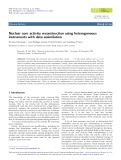
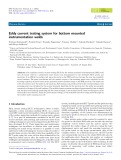
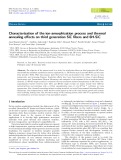
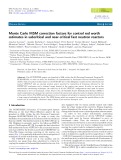



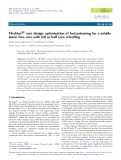
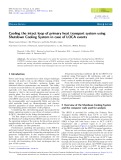






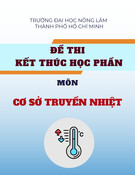

![Ngân hàng trắc nghiệm Kỹ thuật lạnh ứng dụng: Đề cương [chuẩn nhất]](https://cdn.tailieu.vn/images/document/thumbnail/2025/20251007/kimphuong1001/135x160/25391759827353.jpg)






